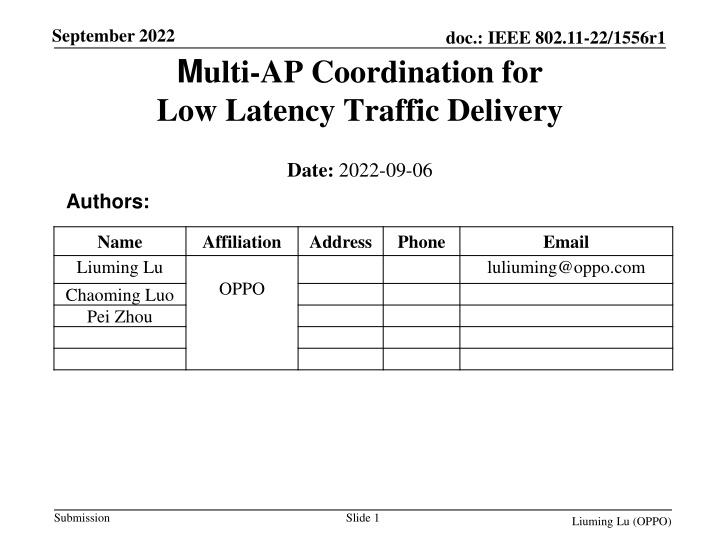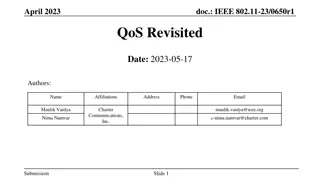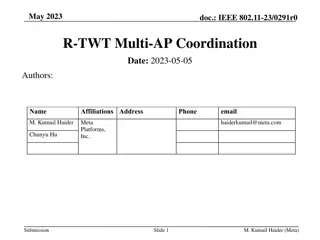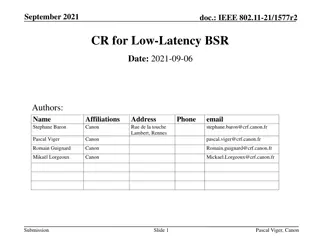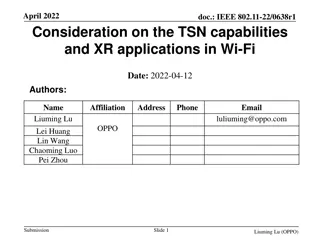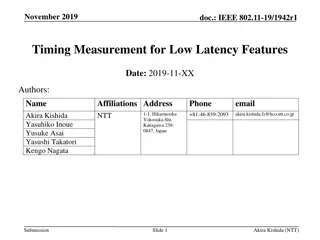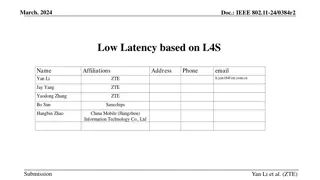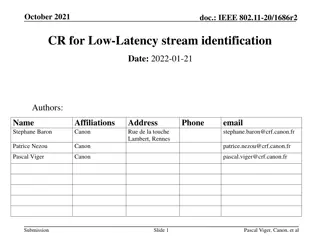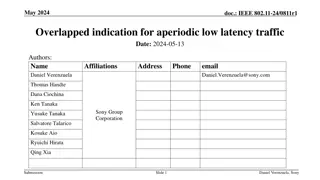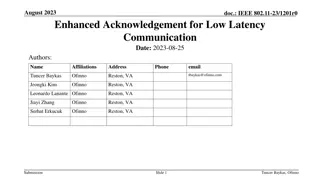Multi-AP Coordination for Low Latency Traffic Delivery
This document discusses the challenges of achieving deterministic and guaranteed latency over wireless links, particularly in Wi-Fi networks. It focuses on the potential enhancements in multi-AP coordination for low latency traffic delivery, aiming to reduce latencies and increase manageability, especially for Ultra High Reliability scenarios.
Download Presentation

Please find below an Image/Link to download the presentation.
The content on the website is provided AS IS for your information and personal use only. It may not be sold, licensed, or shared on other websites without obtaining consent from the author.If you encounter any issues during the download, it is possible that the publisher has removed the file from their server.
You are allowed to download the files provided on this website for personal or commercial use, subject to the condition that they are used lawfully. All files are the property of their respective owners.
The content on the website is provided AS IS for your information and personal use only. It may not be sold, licensed, or shared on other websites without obtaining consent from the author.
E N D
Presentation Transcript
September 2022 doc.: IEEE 802.11-22/1556r1 Multi-AP Coordination for Low Latency Traffic Delivery Date: 2022-09-06 Authors: Name Liuming Lu Chaoming Luo Pei Zhou Affiliation Address Phone Email luliuming@oppo.com OPPO Submission Slide 1 Liuming Lu (OPPO)
September 2022 doc.: IEEE 802.11-22/1556r1 Introduction Achieving determinism and guaranteed latency over wireless links is challenging especially for Wi-Fi using unlicensed spectrum. Although 11be has specified some features to provide predictable latency and jitter for the delivery of latency sensitive traffic, further enhancements are also expected in future project. This contribution focuses on the multi-AP coordination for low latency traffic delivery, which may be considered as a candidate technology to reduce latencies, increase manageability for UHR (Ultra High Reliability). Submission Slide 2 Liuming Lu (OPPO)
September 2022 doc.: IEEE 802.11-22/1556r1 Background 802.11be Features Benefits for the delivery of latency sensitive traffic Application Scope and limitations Multi-Link Operation (MLO) increase throughput by aggregating multiple links across different channels or bands (2.4, 5 and 6 GHz). reduce latency by providing multiple channel access opportunities the usage of preferred link(s) for the TID(s) corresponding to latency-sensitive traffic by TID-to-link mapping Limited to the communication between MLD devices with multiple links. operates using one or more affiliated APs(or STAs) , but has one MAC data service and a single MAC SAP to the LLC sublayer for a MLD each link is located on different nonoverlapping channels QoS signaling enhancements QoS parameters in the QoS Characteristics elements carried in SCS Descriptor Multi-link SCS procedure: creation, modification, or deletion of an SCS stream at the MLD level Limited to QoS signaling between AP and its associated STAs, or AP MLD and its associated non-AP MLD Restricted TWT (R-TWT) enables the BSS to use enhanced medium access protection and resource reservation mechanisms Limited to STAs supporting r-TWT in one BSS OBSS interference is not considered. Submission Slide 3 Liuming Lu (OPPO)
September 2022 doc.: IEEE 802.11-22/1556r1 Potential Features to be enhanced EHT features for low latency traffic delivery Potential UHR features for low latency traffic delivery Enhanced co-channel coordination for multi-ap operation The evolution of the features from multiple APs perspective MLO QoS signaling Extend the medium access protection mechanism to multiple BSSs R-TWT The mechanism to eliminate or mitigate OBSS interference Submission Slide 4 Liuming Lu (OPPO)
September 2022 doc.: IEEE 802.11-22/1556r1 Multi-AP Coordination Multi-AP operation in Wi-Fi Alliance The goal is to expand the network coverage range Form a unified network that provides efficient Wi-Fi throughout Network architecture, system level functionality MAC level coordination of APs operation, such as channels, Bandwidth, Security, etc. Multi-AP Coordination discussed in EHT SG The goal is to achieve higher efficiency and higher throughput. Multiple modes, such as coordinated OFDMA/MU- MIMO/Beamforming, Joint Transmission etc. Strict Time/frequency synchronization is required. moderate time / frequency synchronization accuracy requirements Decrease the signaling and data transmissions among multiple APs Enhance MAC level coordination of APs operation Provide more flexible ways of signaling among APs A suggested mode of Multi-AP coordination for UHR One suggested goal is to provide higher reliability for delivering low latency traffic including enhanced medium access protection for reserved resource during scheduled time The information for the reserved resource and scheduled time needs to be shared among APs The operations of APs in their respective BSSs needs to be coordinated to provide enhanced medium access protection Submission Slide 5 Liuming Lu (OPPO)
September 2022 doc.: IEEE 802.11-22/1556r1 Scenario Low latency traffic for applications including XR (AR/VR/..) accounts for a large part of the network traffic More P2P links and transmissions proliferate due to the diversity of client phones/watches/glasses/helmet/gaming consoles/displays/cameras, etc. Overlapping BSS seems to exist unavoidably especially in dense environment due to limited unlicensed spectrum and the deployment of MLO devices devices, such as Submission Slide 6 Liuming Lu (OPPO)
September 2022 doc.: IEEE 802.11-22/1556r1 Candidate Solution Multi-AP Coordination for Low Latency Traffic Delivery Multiple APs are coordinated to provide enhanced medium access protection The related information is shared among APs, such as the resource to be protected and the interfering STAs Action to protect the resource reserved by neighboring BSS is taken for the interfering STAs, such as: the interfering STAs stop its TXOP before the start time of the scheduled time limit the transmission initiated by the interfering STAs during the scheduled time. Submission Slide 7 Liuming Lu (OPPO)
September 2022 doc.: IEEE 802.11-22/1556r1 Use Case - 1 (1) BSS-1 BSS-2 causing interference to transceiving Scheduled transmission (to be protected) STA 2-1 AP2 AP1 Scheduled transmission (to be protected) STA 1-3 STA 2-2 STA 2-4 STA 1-2 STA 2-3 STA 1-1 An example :the STA whose transmission needs to be protected is in the overlapping area of the co-channel BSSs Submission Slide 8 Liuming Lu (OPPO)
September 2022 doc.: IEEE 802.11-22/1556r1 Use Case - 1 (2) (3)The information is shared among APs including: The reserved resource to be protected at scheduled time in respective BSSs (4) The interfering APs/STAs from OBSS whose transmissions would affect the transceiving of the participating APs/STAs using the reserved resource at scheduled time BSS1 BSS2 the STA whose transmission needs to be protected (5) Action to protect the reserved resource in BSS2, such as end the TXOP at the start of scheduled time in BSS1 etc. Scheduled transmission (to be protected) OBSS PPDU STA 2-1 AP2 AP1 (1) obtain information for the interfering AP/STA from received inter-BSS PPDU (2) report information for the interfering AP/STA(BSSID, BSS color, Partial AID, AID etc. ) Scheduled transmission (to be protected) STA 1-3 STA 2-2 STA 2-4 STA 1-2 STA 2-3 STA 1-1 Submission Slide 9 Liuming Lu (OPPO)
September 2022 doc.: IEEE 802.11-22/1556r1 Use Case - 2 (1) BSS-2 BSS-1 STA 2-1 AP2 AP1 Scheduled transmission (to be protected) STA 1-3 STA 2-2 STA 2-4 Scheduled P2P transmission (to be protected) causing interference to transceiving STA 1-2 STA 2-3 STA 1-1 An example :the STA whose transmission needs to be protected is outside of the overlapping area of the co-channel BSSs Submission Slide 10 Liuming Lu (OPPO)
September 2022 doc.: IEEE 802.11-22/1556r1 Use Case - 2 (2) (3) The information is shared among APs including: The reserved resource to be protected at scheduled time in respective BSSs (4) The interfering APs/STAs from OBSS whose transmissions would affect the transceiving of the participating APs/STAs using the reserved resource at scheduled time BSS1 BSS2 STA 2-1 AP2 AP1 (2) report the information for the interfering STA(BSSID, BSS color, Partial AID, AID etc. ) (5) Action to protect The reserved resource in BSS1, such as disallowing STA 2-2 to initiate the transmission during the scheduled time in BSS2 STA 1-3 Scheduled transmission (to be protected) STA 2-2 STA 2-4 OBSS PPDU Scheduled P2P transmission (to be protected) (1) obtain information for the interfering AP/STA from received inter-BSS PPDU STA 1-2 STA 2-3 STA 1-1 the STA whose transmission needs to be protected Submission Slide 11 Liuming Lu (OPPO)
September 2022 doc.: IEEE 802.11-22/1556r1 Summary Further enhancements to the features for the delivery of low latency traffic are expected in UHR SG. A mode of Multi-AP coordination is suggested to provide higher reliability for delivering low latency traffic including enhanced medium access protection for reserved resource during scheduled time across different co-channel BSSs. Submission Slide 12 Liuming Lu (OPPO)
September 2022 doc.: IEEE 802.11-22/1556r1 Straw Poll Do you agree that UHR should specify a mode of multi- AP coordination to provide higher reliability for delivering low latency traffic including enhanced medium access protection for reserved resource during scheduled time among co-channel BSSs? Submission Slide 13 Liuming Lu (OPPO)
September 2022 doc.: IEEE 802.11-22/1556r1 Reference [1] IEEE 802.11be Draft 2.1.1 [2] 11-22-0729-01-0wng-next-generation-after-802-11be- follow-up [3] 11-22-0779-00-0wng-802-11bx-enabling-metaverse- metaverse-ar-vr-and-wearables [4] 11-22-0634-02-00be-802-11be-enhancements-for-tsn- time-aware-scheduling-and-network-management- considerations [5] 11-18-1509-00-0eht-features-for-multi-ap-coordination Submission Slide 14 Liuming Lu (OPPO)
